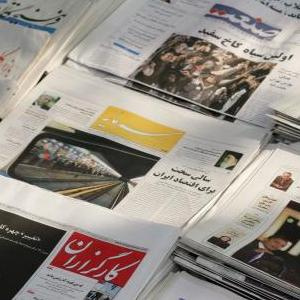Tehran’s Daily Newspaper Review

As Tehran Stock Exchange’s main index (TEPIX) hit an all-time record high of +27 thousand, and the total market value was estimated to reach approximately 129 billion dollars, Iran reported of the fourth record-breaking of the Persian year 1390 [March 2011-March 2012]. Iran also tried to corroborate Ahmadinejad’s controversial remarks on Wednesday, quoting the senior official in charge of the Purposeful Subsidies plan that tripling the liquids subsidies is feasible; and interviewing “theology and philosophy” scholars who backed Ahmadinejad’s remarks and stated that “humans can be the manifestation of God’s attributes, including creation.” The newspaper also quoted two senior Sepah officials who stated that, “Iran’s defense power is beyond the assumption of the enemy.”
“Zionists flee from Cairo,” Kayhan published triumphantly, calling “the seizure of Israel’s embassy, (the) Egyptians’ response to the Camp David treason”. Kayhan also reported of “Western intelligence services being on alert to counter Iran’s cyberattacks”. The newspaper’s editorial, written by Editor-in-Chief Hossein Shari’atmadari, linked the 3 billion dollar embezzlement scandal to the newly-established private banks which are allegedly linked to the Astray Current-- codename for Esfandiar Rahim Mashaei’s circle. Shari’atmadari also criticized the Judiciary for lenient treatment of the case.
Resalat’s front page covered the “seizure of the Zionist Regime’s embassy by Egyptian revolutionaries”, also featuring a picture of Egyptian protestors setting Israel’s national flag on fire. The newspaper also quoted former Majles’ Speaker Haddad-e Adel, who called for unity among the Principlists before it was too late. Habibollah Asgarowladi, veteran Conservative politician, called elections “an opportunity to reinforce national security”, a paraphrase of Ayatollah Khamenei’s recent remarks in which he had warned about (upcoming parliamentary) elections turning into a security challenge. “Globalization of Religious Democracy”, Resalat’s headline, called for promotion of the Iranian model of democracy-- rooted in Islamic doctrines-- among Arab countries where the uprisings have born fruit, to counter Western countries’ manipulation of the revolutions.
Shargh focused on the media silence about a meeting between the heads of the three powers. The meeting, with financial corruption typically on the top of the agenda, was held as the news of a 3 billion dollar embezzlement inside the banking system has attracted widespread attention. Shargh covered the developments in Cairo with a milder tone, choosing the headline “protestors attack the Israeli embassy in Egypt.” The newspaper also cited influential MP Ahmad Tavakkoli, who had threatened to submit evidence of financial corruption of some Majles members to the Guardian Council, the body in charge of qualifying candidates for the parliamentary and presidential elections. Shargh’s editorial was written by Nazim Dabbagh, Kurdistan Autonomous Region’s envoy to Tehran, in criticism of Tel Aviv’s policy of befriending Kurds to undermine its two regional rivals, Turkey and Iran.
Tehran-e Emrooz’ top headline, “the second Egyptian Revolution begins”, was meant to evoke the early months after the Islamic Revolution, when Islamist Leftists students (i.e. the Marxist students) seized the US embassy in Iran, and were supported by the late Leader Ayatollah Khomeini who called their initiative the Second Revolution. “Unanswered questions about the big embezzlement” was another major headline of the newspaper, focusing on the scandal at one of the largest Iranian banks, Bank-e Saderat (lit. “The Export Bank of Iran”). In the editorial, Hesameddin Kaveh argued that against the ambitions of Washington’s New Middle East plan, the new Middle East will be Islamist. No more can the US launch coups against its governments, and neither can it bargain with regional dictators to exploit countries’ resources.
Vatan-e Emrooz also chose the headline “Egypt’s second revolution”, adding that the Egyptian revolutionaries were inspired by the seizure of the US embassy in Tehran. This was an assumption also iterated by Chief Commander of Basidj Forces, Mohammad-Reza Naghdi.
* Notes
The editorial section of Iranian newspapers is not always the work of the editor-in-chief or the senior editorial staff of the newspaper, but can be a contribution by experts and politicians (typically agreeing with the newspaper’s political stance.) Editorials may not be published on a daily basis in some newspapers.
Vatan-e Emrooz does not publish on Thursdays.
Trouble with understanding some terms? Check our Glossary of Iranian Political Terms.
Briefing
Hamshahri (Citizen) is the official daily newspaper of Tehran's Municipality. Its general directions in politics, culture and economy are determined by the mayor of Tehran, currently Mohammad Baqer Qalibaf.
Iran is the official organ of the administration.
Jomhouri-ye Eslami (The Islamic Republic) was known as the official organ of the Party of the Islamic Republic, founded in 1979 and disbanded in 1987. Currently, it is an open critique of Mahmoud Ahmadinejad's policies and is known to be a mouthpiece of Akbar Hashemi Rafsanjani.
Kayhan (Universe) is a hard-line conservative newspaper. Its editor-in-chief –currently Hossein Shari’atmadari- is appointed by Iran's Supreme Leader. Shari’atmadari’s editorials often spark off controversy and debate inside Iranian political circles.
Resalat (Mission) belongs to the moderate wing of the principlist camp. Resalat’s best known analyst is Amir Mohebbian, its political editor.
Shargh (East) is a moderate reformist newspaper. It was the most popular and influential reformist newspaper in its first period of publication which lasted from August 2003 until September 2006.
Tehran-e Emrooz (Tehran Today) is a ‘principlist reformist’ newspaper, connected to Mohammad Baqer Qalibaf.

